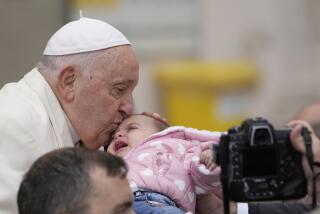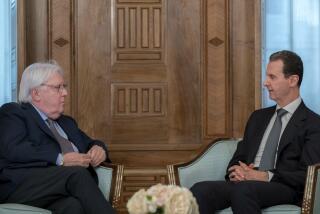Amid Golan Ruins, a Papal Plea for Peace
- Share via
KUNEITRA, Syria — Pope John Paul II knelt Monday in the wreckage of a Greek Orthodox church, surrounded by the debris of a once-thriving market town, and implored the antagonists of the Holy Land to be as forgiving of one another as their God is.
This ghost town on the Golan Heights, a deliberately preserved reminder of wars fought in 1967 and 1973, haunted the region on a day of ongoing Arab-Israeli bloodshed.
For the 80-year-old Roman Catholic leader, who followed the footsteps of St. Paul to this wind-swept battleground, Kuneitra was “a fitting place to pray for peace,” in the words of his spokesman.
But for Syria, it was also a propaganda victory over Israel, whose occupying army left Kuneitra in ruins 27 years ago. As John Paul today winds up his first visit to this country, Syrians are jubilant over their four days in the papal limelight--and Israelis seething over how it looked to the world.
Syria, which lost the entire Golan in the 1967 Middle East War, says Israeli forces razed Kuneitra with bulldozers and dynamite before withdrawing under a U.S.-mediated armistice of the 1973 Yom Kippur War. Syria refuses to rebuild the town, saying it should stand as a monument to Israeli crimes until the rest of the Golan is back in Syrian hands.
Israel, which claims the town was destroyed by fighting, had offered to relinquish land in return for security guarantees. But peace negotiations with Syria have been stalled since early last year.
Seizing on the pope’s 45-minute stop in Kuneitra, the Syrian government bused in several thousand former inhabitants for the day, putting them before the cameras and reporters from around the world who are recording the papal pilgrimage.
The refugees strung up banners in English and Arabic in the debris of what once was a mixed Muslim-Christian community of 53,000 people.
“Kuneitra had four mosques and three churches,” one banner read. “The calls from the minarets and the tolling of the church bells are no longer heard, and the worshipers were driven out.”
The town, set between Mt. Hermon and rolling green fields with cypress trees, looks as if it was hit by an earthquake. Not a single building remains intact.
A 13-year-old girl, Lin Doughouz, handed the pope a letter saying her parents have taught her that Kuneitra was “the flower of the Golan” before “the enemy destroyed its houses so savagely.”
Syrian officials stage such gatherings for every visiting foreign official they can coax here. But the country’s relative isolation--for its links with Palestinian radicalism and sponsorship of terrorist groups--gives Kuneitra a low profile. Until Monday, the presidents of Algeria and Slovakia were the only heads of state to have set foot here over the past decade, Syrian journalists say.
The pope’s arrival gave the Syrians a diplomatic windfall.
“His presence is a message to the whole world that what Syria says about [Israeli] injustice is right,” Metropolitan Sabbah Esper, head of the Greek Orthodox community in this part of the Golan, told reporters as he waited for the pontiff outside the damaged church.
The roof of the church appears to have been pierced by a missile, its now-vacant interior scorched by fire. Orthodox clerics say the Israelis made off with its icons, bells, lamps and marble furnishings, leaving a stone and concrete hulk.
John Paul was cheered by flag-waving refugees, some with children hoisted onto their shoulders, as he blessed an olive tree and entered the church on a low wooden catwalk that had been built over the floor to keep him from tripping over shattered tiles.
After kneeling in silence, he read a prayer “from this place, so disfigured by war,” asking believers of all faiths to “break down the walls of hostility” and “find the courage to forgive one another so that the wounds of the past may . . . not be a pretext for further suffering in the present.”
The “sad news” of a 4-month-old Palestinian girl’s death Monday, he said, makes “our prayers even more intense.” The infant was hit by shrapnel from Israeli tank fire aimed at a Gaza Strip refugee camp in response to mortar fire on two Jewish settlements.
The pope’s prayer avoided pointed condemnation of either side in the Arab-Israeli conflict and asked God to grant Syria’s leaders wisdom, farsightedness and perseverance in the pursuit of peace.
No Syrian leader addressed the pope in Kuneitra; government officials said the powerful images of destruction spoke for themselves.
But commentators on state television, which carried the event live, said the pope’s visit to the town offered proof of Israeli atrocities and legitimized Syria’s struggle to “liberate” the entire Golan and other Israeli-occupied land.
Israeli leaders have protested Syrian President Bashar Assad’s exploitation of the papal limelight to portray the Jews as 1st century executioners of Jesus Christ and as modern-day war criminals. The Israeli Foreign Ministry on Monday urged the Vatican to “find the appropriate opportunity,” while the pope is still in Syria, to renounce Assad’s “hateful slander.”
Assad “absorbed hatred for Israel from his early childhood” when his father was president “and has upgraded it,” Shalom Yerushalmi wrote Monday in the Israeli newspaper Maariv. “He is transferring the conflict onto religious tracks,” hoping to deflect attention from Syria’s official corruption at home and its military occupation of Lebanon, the commentator added.
Syrians have voiced pride in the pope’s recognition of the tolerance prevailing among this country’s 2 million Christians and several Islamic sects. Over the weekend, Catholics and Orthodox Christians prayed together with John Paul, and Syria’s grand mufti was the first Muslim ever to usher a pope into a mosque.
The Syrians’ insistence on bringing the pope to Kuneitra reminded Vatican officials of other blunt propaganda ploys during his 93 trips abroad. His hosts in Bangladesh, for example, diverted John Paul 60 miles outside their capital just so he could bless a monument to the country’s independence. And Chilean officials maneuvered him into position for an unwanted photo with dictator Gen. Augusto Pinochet.
But papal spokesman Joaquin Navarro-Valls said Monday that the Vatican “couldn’t care less” about Syria’s manipulation of the Kuneitra visit because “the majority of people in Syria and the Middle East appreciate the Holy Father’s trip and his prayers in this symbolic town.”
St. Paul is believed to have passed through or near Kuneitra on the road from Jerusalem to Damascus in the 1st century. The Bible says that Jewish leaders in Jerusalem sent Paul, then a Jew, to combat the spread of Christianity but that he was blinded by a vision of Jesus on the way and became a Christian.
Today such a journey would be impossible, as traffic between Israel and Syria across the Golan is closed. Kuneitra lies inside a military buffer zone monitored by U.N. troops.
*
Times staff writer Tracy Wilkinson in Jerusalem contributed to this report.
More to Read
Sign up for Essential California
The most important California stories and recommendations in your inbox every morning.
You may occasionally receive promotional content from the Los Angeles Times.










